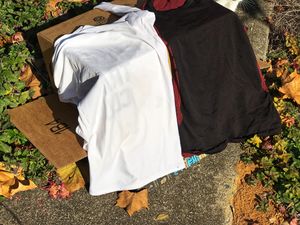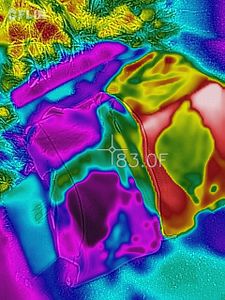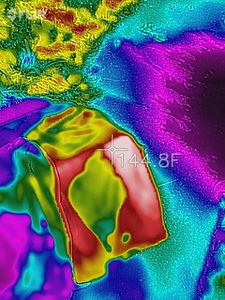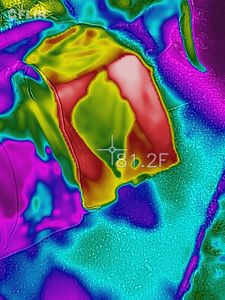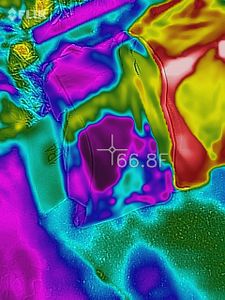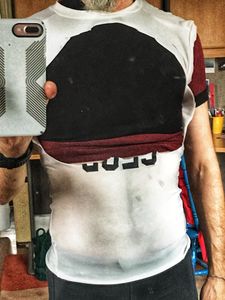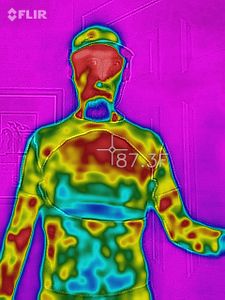XOSKIN Review
I'm always fascinated by new technology, and the XOSKIN clothing has several intriguing features. I purchased one of their form fitting tops to compare against my current favorite, the UnderArmour HeatGear. I've been wearing HeatGear since at least 2009, and it served me well on some of the most grueling ultramarathons. However, HeatGear suffers badly from odor when I'm on vacation and I can't wash my running gear easily. The worst case is when I'm staying somewhere different each day, which means storing my sweaty gear in a plastic bag all day. So how does XOSKIN stack up against my current favorite?
- XOSKIN makes use of modern 3D knitting techniques to create a seamless garment. I think that the result is a garment that might fit a little better than the UnderArmour HeatGear, though the difference is fairly minor. Both garments have a good level of elasticity, and fit my body shape without any problems. The lack of seems is a nice feature, though I've never had an issue with UA HeatGear, even after long ultramarathons.
- The type of material varies across of the garment, with a goal of providing muscle support where it's needed. This seems to be reminiscent of CW-X garments that provide reinforcement in certain areas. I've never found this approach to make any difference in practice, and given the forces involved in movement and the relatively small pressure differential provided, I wouldn't expect to see any benefit. True compression gear that provides noticeable pressure is quite different. An XOSKIN top is not providing the level of compression you'd get with a calf compression sleeve for instance. The material in XOSKIN also has different structures in various areas, such as bumps that spread the sweat over a greater area, or sweat traps under the arms. I didn't notice these features one way or the other.
- XOSKIN claims to reduce friction between the fabric and your skin. I couldn't tell any difference in general usage, though I suspect the only time I would notice is when I was putting the top on. I would expect a compression top to stay in place, and I'd look for a reduction in friction between the fabric surfaces, such as under the arms.
- The material used in XOSKIN is quite a bit thicker than HeatGear, somewhere around twice as thick would be my guesstimate. So, while XOSKIN may have some advanced technology to improve moisture transport, it doesn't make up for the extra thickness. I found that it generally kept me quite a bit warmer than HeatGear, both when wet and when dry. XOSKIN also holds more sweat, so it takes longer to dry off when running than the thinner HeatGear. I've found that can make it harder to control my temperature when running in cool conditions.
- Unfortunately, XOSKIN is only available in fairly dark colors, which makes it problematic if you're running when exposed to sunlight. You can see some of my tests below, which highlight the issue. This testing reflects my subjective experience with the dark colors of XOSKIN soak up the heat from the sun.
- XOSKIN uses copper layered over the fibers, which they claim reduces the buildup of odor. I can't say if it's a copper, or something counts, but XOSKIN has an amazing ability to resist odor. I trained in an XOSKIN top every day for a week without washing it. After training, I stored the top in a sealed Ziploc bag, taking it out overnight to dry off. This is to stimulate a typical day of vacation, where I have to store my running gear during the day while we traveling. After a week of this abuse, there was not the slightest hint of odor. Under similar conditions my UnderArmour HeatGear doesn't just stink, it's like teargas!
My conclusion is that HeatGear remains my top pick for training and racing, but XOSKIN is a clear winner for travel. I love Merino wool, but it's not available as a thin compression top, is expensive, and very delicate. I wear Merino wool tee shirts when I'm travelling, for hiking and tourism, but it just doesn't work when running. I've used the XOSKIN for a full day's running on my 40 miler at Wainwrights Coast To Coast, and it remains comfortable. That was cold, wet conditions with rain and snow, so the extra insulation was not an issue.
1 XOSKIN and HeatGear in the Sun
The setup is a white UnderArmour HeatGear top on the left against a XOSKIN top on the right. Both have 2 tablespoons/30ml of water placed on their centers, and both are left in the full sun for ~15 minutes on a 66f/19c day. The images are taken with a FLIR Thermal Camera. The XOSKIN is far hotter than the HeatGear, both when wet and when dry. (Note that this is not intended to reflect real-world running conditions. It simply highlights how important color is to your temperature control when running.)
The dry area of the UnderArmour HeatGear top is 83f/28c
The wet area of the UnderArmour HeatGear top is 67f/20c
2 XOSKIN and HeatGear on the Run
I tried a number of different approaches to compare how the two garments functioned when running. If I could afford it, I would cut them in half down the middle and to sew them together so that I have one material on one side and another on the other. Unfortunately, because I buy all my own gear retail, I can't really afford to do this. However, I did have an aged HeatGear top that I was prepared to sacrifice. I cut the arms off, and I cut most of the chest area over the rib cage off. Then I put the XOSKIN on and rolled up the bottom so that the bundled material is roughly where my heart rate monitor strap goes. Putting the hacked HeatGear top over the XOSKIN results in just the HeatGear over my belly and just the XOSKIN over my chest, with doubled up in other areas. This is far from perfect, as skin temperature could vary between the chest and belly, and because humans are highly adaptive, skin temperature might not reflect thermal stress. However, it seems like a good compromise for someone who can't afford to sacrifice too much gear. The perceived difference is dramatic; my HeatGear covered belly felt naked and exposed while my XOSKIN covered chest felt quite a lot warmer. The FLIR thermal sensor shows the warmer XOSKIN (~90f/32c) and the cooler HeatGear (~80f/26c), confirming my perception.
